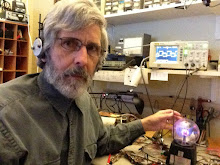I approached this with a little anxiety because, what if I accidentally hook the scope probe's ground lead to the hot side of the line? So I took some precautions. First, I connected the generator's ground terminal to the ground wire at my meter. Inside the house, I plugged an extension cord into the wall and verified that I knew which side is the "hot" side on the other end. I verified 120 VAC from that side to system ground (the case of a piece of equipment with 3-wire plug). I looked at the utility's waveform on my scope and it looked OK. I didn't need to hook up the grounded side of the probe, since all grounds are common.
Next I unplugged the cord from the wall and took it outside and plugged it into my Honda eu2000i generator. I also plugged in a 60 W lamp, for just a bit of load.
I came back inside and re-checked the voltage on the hot lead to ground with my DMM. Here's where I got a surprise. Instead of 120 VAC, I read 60 VAC. So I moved the probe to the neutral lead and it's also 60 VAC. What's going on? It looks like the ground terminal on the generator is at the center point of the output, not on one side. Unless I'm missing something.
Here's what the waveform looked like:
Pretty good! It actually looked a bit more sine-like than what was coming out of the wall.
73-
Nick, WA5BDU


1 comment:
Commenting on my own post ... the manual for the generator states that neither side of the output is grounded and that the 3rd wire and ground terminal simply connect to the frame. So this is essentially a floating system. It's not unusual for floating system to measure half voltage to ground on both sides - there's some leakage resistance and capacitance to ground which will normally be approximately equal from either side to ground.
Post a Comment